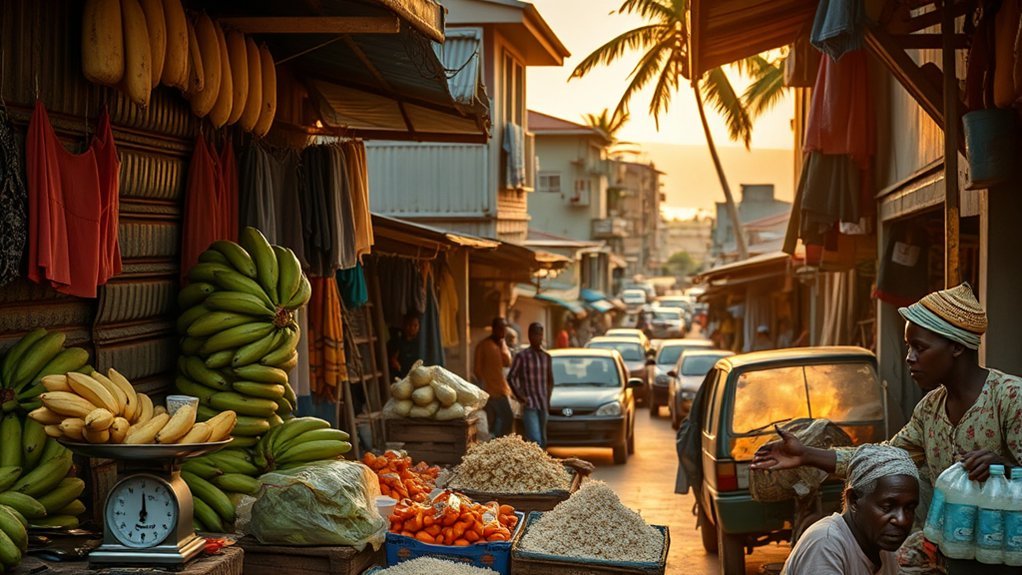You’ll find living costs in Sierra Leone vary a lot by lifestyle: a local standard runs roughly 2.5–5 million SLL monthly, while an expatriate budget is about 6.5–11 million SLL. Rent and imported groceries drive most differences — one‑bed expat rents hit 5–8 million SLL, local rents 1–2 million. Utilities, internet, private healthcare and schooling add substantial sums. Below you’ll get a breakdown of housing, food, transport and other key cost drivers.
Sierra Leone at a Glance: Key Facts and Cost Drivers
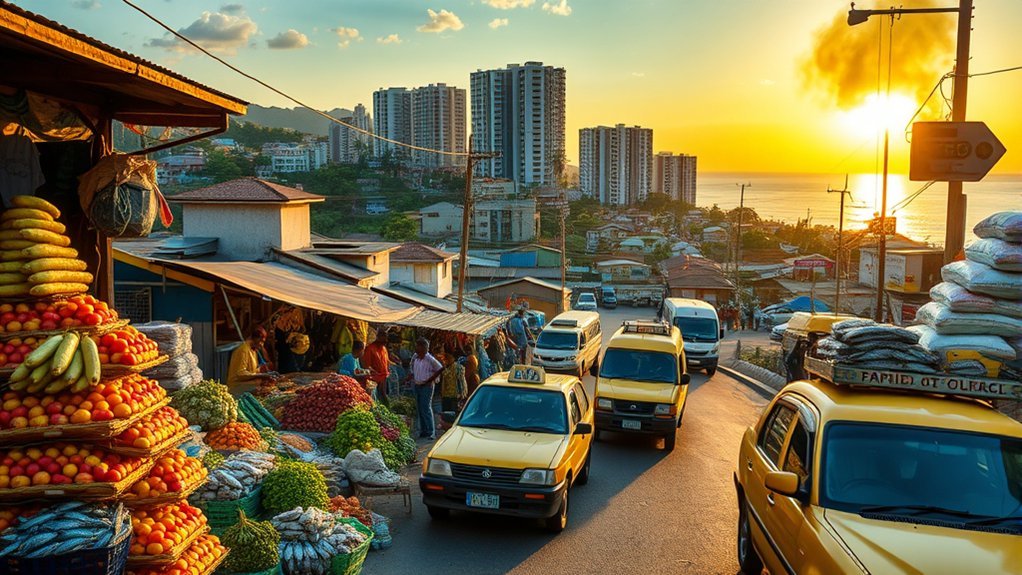
Although Sierra Leone’s economy leans on mining, agriculture and a growing services sector, the cost of living shows sharp divides between expatriate and local standards: you’ll see stark contrasts in prices for Sierra Leone essentials.
With ~8 million people, national averages mask expatriate pockets where one-bedroom rents hit 5,000,000–8,000,000 SLL/month versus local rents of 1,000,000–2,000,000 SLL. Local meals cost 50,000–100,000 SLL; international restaurants charge 200,000–400,000 SLL per person, so dining choices drive budget gaps.
Transport ranges from 20,000–50,000 SLL per taxi ride; owning a car runs 1,500,000–2,500,000 SLL monthly. Private international-standard healthcare consultations cost 500,000–1,000,000 SLL, underlining higher expatriate medical spending.
If you compare Leone vs United States benchmarks, basic services are cheaper nominally but limited in quality and availability. Living in Sierra Leone consequently requires evaluating whether you’ll adopt local consumption patterns or expatriate standards.
Help us quantify these drivers to guide cost-of-living planning.
Housing and Utilities: Rent, Bills, and Internet Costs
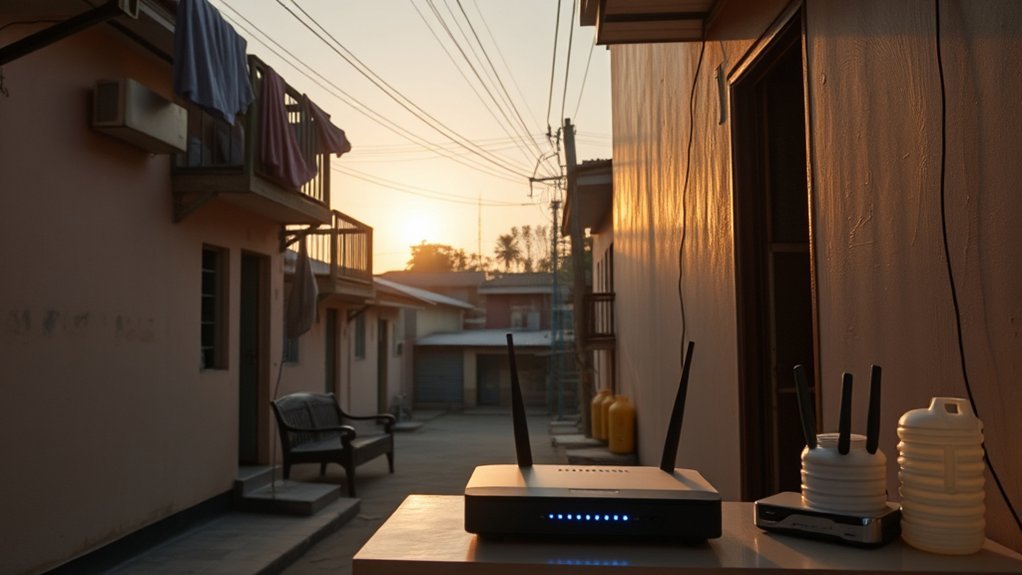
Moving from broad cost drivers to concrete household expenses, housing and utilities are where you’ll see the biggest split between expatriate and local living standards.
You’ll pay 5,000,000–8,000,000 SLL monthly for a one-bedroom in expatriate areas versus 1,000,000–2,000,000 SLL in local neighborhoods. Expect many expatriate leases to demand six months to a year’s advance rent, so your upfront cash requirement can be large.
Monthly utilities (electricity, water, basic services) typically add 1,000,000–2,000,000 SLL to your budget, regardless of neighborhood, though reliability and supplemental costs (generators, water delivery) can raise that.
Internet plans with adequate speed run about 500,000–1,000,000 SLL per month; corporate or faster options cost more.
Compare total monthly housing-related outlay: in expatriate areas you’re looking at roughly 6,500,000–11,000,000 SLL, while local living typically totals 2,500,000–5,000,000 SLL.
That gap drives most differences in household cost of living.
Food and Groceries: Local Markets vs. Imported Goods
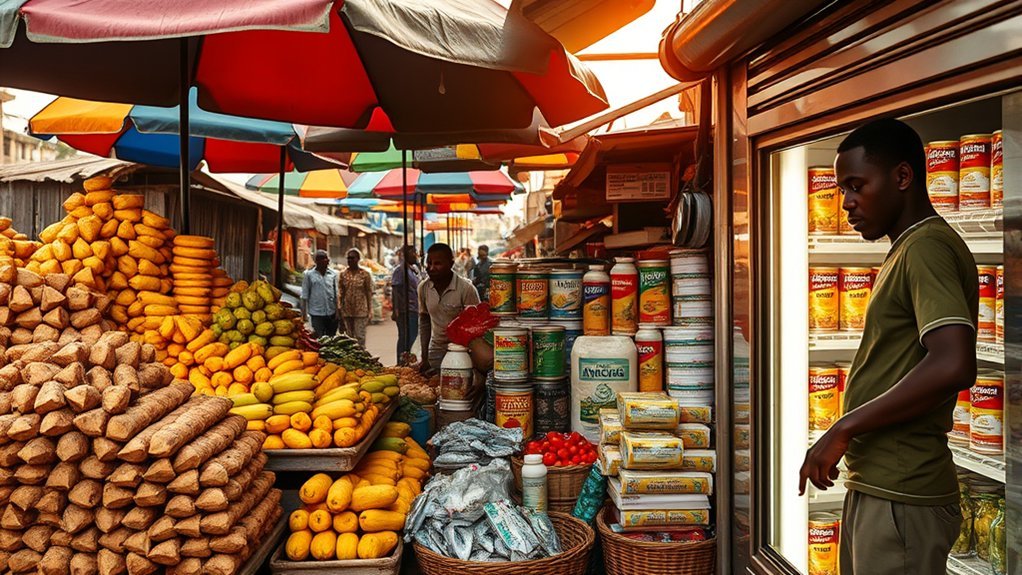
When you shop in Sierra Leone, local markets will stretch your leones much farther than expatriate supermarkets: a loaf of bread runs about 5,000 SLL and a dozen eggs about 2,000 SLL at local vendors, while monthly grocery bills at expat-oriented stores typically hit 2,000,000–3,000,000 SLL—driven largely by expensive imported items; expect restaurant meals to mirror that split, with local eateries at 50,000–100,000 SLL versus 200,000–400,000 SLL at international spots.
You’ll find fresh produce, staples and street food reliably cheaper at open-air markets. Imported items — specialty cheeses, cereals, canned goods, branded beverages — create the large cost gap: a few imported products can double a shopping cart’s price.
If you prioritize local ingredients and markets, monthly food costs stay low and predictable. If you prefer imported brands or shop at expat supermarkets, budget for a substantial premium. Plan meals around seasonal local produce and use markets for basics to control your food spending effectively.
Transportation and Daily Mobility Expenses
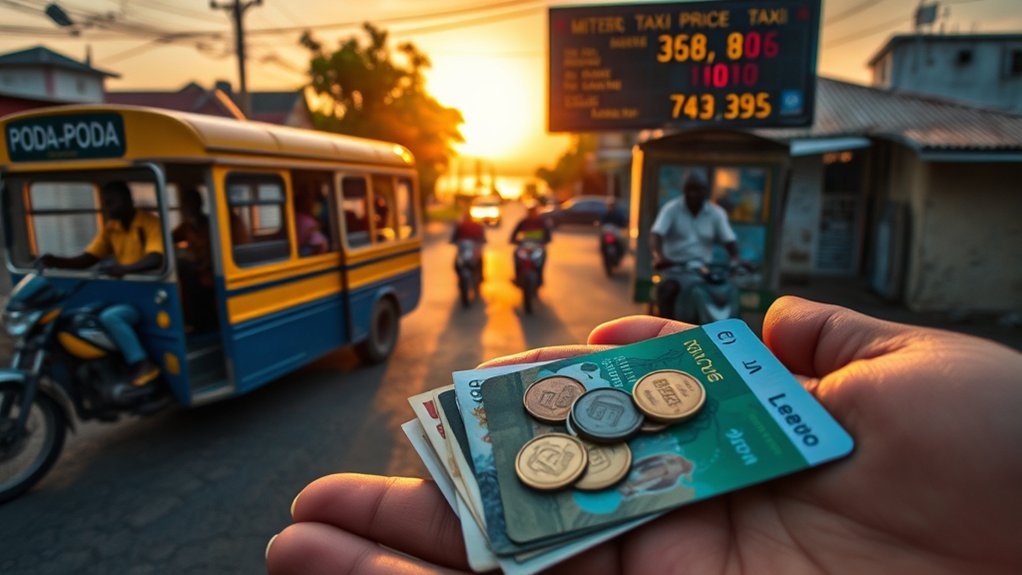
After you’ve priced food, transport becomes the next predictable monthly expense to budget for: local taxi rides typically cost 20,000–50,000 SLL while okadas run 10,000–20,000 SLL, making short trips inexpensive compared with many countries — an 8 km downtown taxi is about $10.90 USD.
You’ll find taxis and okadas cover most short trips; public transit is limited, so expats often rely on private or employer-provided vehicles.
If you own a car, expect monthly costs of roughly 1,500,000–2,500,000 SLL for fuel and maintenance, which can flip mobility from cheap to a significant line item.
Compared with U.S. city taxi rates, Sierra Leone’s per-ride costs are lower, but car ownership narrows that gap.
Plan based on trip frequency: frequent commuters may prefer the predictability of a car or shuttle; occasional users save by mixing taxis and okadas.
- Short trips: okada 10k–20k SLL, taxi 20k–50k SLL
- Car ownership: 1.5M–2.5M SLL/month
- Public transit: limited; factor in employer options
Healthcare, Education, and Insurance Costs

You’ll pay a premium for reliable private healthcare—insurance runs about 1,000,000–2,000,000 SLL monthly and consultations 500,000–1,000,000 SLL.
International-school tuition is often higher still, frequently reaching several million SLL per term depending on curriculum.
Compared with local clinics and public schools, these private options substantially raise monthly family expenses.
Private Healthcare Costs
Although public services are limited, private healthcare in Sierra Leone gives you predictable but comparatively high out-of-pocket costs: private health insurance runs about 1,000,000–2,000,000 SLL per month depending on coverage, while consultations at international-standard clinics cost roughly 500,000–1,000,000 SLL.
You’ll likely rely on private options if you want consistent quality, especially in Freetown where most facilities and expatriate-focused clinics are located. Vaccinations and preventive care add variable expenses; budget for them separately.
Compare plans for inpatient coverage, evacuation, and outpatient caps to avoid surprise bills. Costs are higher than regional public alternatives but offer faster, more reliable care.
- Private options concentrated in urban Freetown, limited elsewhere
- Expatriates commonly choose insurance + pay-as-you-go consultations
- Preventive care fees vary by service and clinic
Schooling and Tuition Fees
If you’re weighing schooling options in Sierra Leone, expect wide cost differences: international schools typically charge $5,000–$15,000 per year depending on grade and curriculum, while local primary fees average 200,000–1,000,000 SLL per term.
You’ll find expatriate families favor international schools for curriculum continuity and standards, which explains the premium.
Factor in ancillary costs: uniforms, books, and extracurriculars typically add $500–$1,000 annually.
Also account for student healthcare: private insurance for international school enrollment can run about 1,000,000–2,000,000 SLL per month, substantially raising total education-related expenses.
If you need to budget, compare total yearly outlay (tuition + extras + insurance) across schools rather than tuition alone to see the real cost differential.
Salary, Purchasing Power, and Expense Comparison With the United States
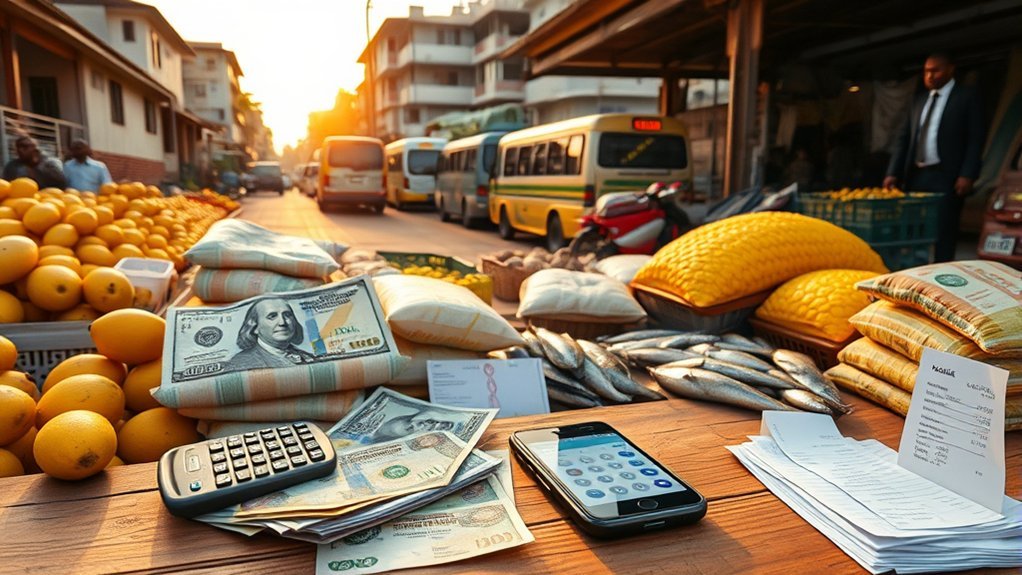
Because wages in Sierra Leone are much lower than in the United States, your purchasing power depends heavily on local prices: overall living costs are about 37.4% cheaper, with groceries 23.2% lower and transport 18.3% lower, while housing is only marginally cheaper (about 3.3%).
Lower wages mean purchasing power in Sierra Leone hinges on much cheaper local prices—housing savings are minimal.
For example, a basic restaurant meal runs roughly $3.00 versus $19.45 in the U.S., a loaf of bread $0.67 versus $3.56, and a downtown taxi trip about $10.75 versus $17.61—so salaries must be considered alongside these price differentials to assess real income and lifestyle.
You should compare nominal salaries to local price levels: a lower paycheck can still afford a comparable standard of living if most expenses are local and inexpensive. Housing narrows the gap, so urban renters feel tighter margins.
If you earn in foreign currency or remit income, your purchasing power rises considerably. Use local price indices and wage data to model net purchasing power before relocating.
- Prioritize local vs. imported expenses
- Factor housing’s small savings into budgets
- Consider earning currency and remittances
Frequently Asked Questions
What Is the Average Salary in Sierra Leone in US Dollars?
You’ll earn about $1,500 per year on average in Sierra Leone. That’s far below Western averages; expatriates and sectors like mining or NGOs can pay much more, creating significant income disparities across the population.
Are Things Expensive in Sierra Leone?
No, you won’t find things expensive overall; costs are about 37.4% lower than the U.S., with cheaper dining ($3 vs $19.45), groceries ($0.67 bread), transport and generally lower housing than U.S. averages.
Is Sierra Leone a Good Place to Live?
Yes — you might find Sierra Leone appealing: costs run about 37.4% below U.S., rent and services vary wildly, dining and transport are cheap, but healthcare and expat housing can be costly, so weigh priorities carefully.
How Much Will It Cost to Build a House in Sierra Leone?
You’ll spend roughly 1,500,000–4,000,000 SLL per square meter to build, with skilled labor 50,000–100,000 SLL/day; expect 6–12 months construction, and add 10–20% for permits/land and higher costs if you import materials.
Conclusion
Living in Sierra Leone can be surprisingly affordable: average rent for a one‑bed in Freetown runs about $300–$500 monthly, roughly 20–30% of typical local incomes. You’ll notice food from local markets costs a fraction of imported goods, and public transport is cheap but limited. Compared with the U.S., where median rent soaks up over 40% of income, Sierra Leone’s lower nominal costs still reflect lower wages—about $1,200 annual GDP per capita.

